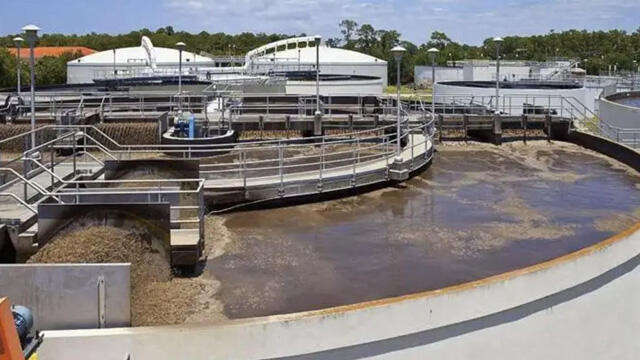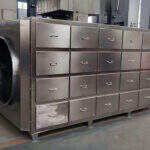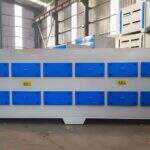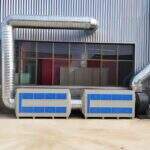Common sludge dewatering machine includes centrifugal dewatering machine, belt dewatering machine, screw stacker, plate filter press, etc. The processing capacity of sludge dewatering machine is closely related to sludge dewatering effect and processing cost. The multi-disc screw press is a dewatering equipment that can operate continuously. It has the characteristics of easy separation of mud and water, not easy to block, and small footprint. The moisture content of the mud is generally 75% to 80%; the plate filter press mainly Using the pressure difference on both sides of the filter medium as the driving force, the filter cloth is used to separate the water and solid particles in the sludge, so as to realize the sludge dewatering. . Due to the good dewatering effect of plate filter presses, it is widely used in the renovation of sludge dewatering systems in sewage treatment plants. However, due to its intermittent operation, in order to increase the sludge treatment capacity, multiple sets of equipment are required to meet the sludge treatment capacity. requirements, the equipment investment cost is high. The treatment of printing and dyeing sludge has always been a “headache” problem for textile printing and dyeing enterprises.
In order to overcome the problem of low processing efficiency of the plate filter press in this project, a multi-disc screw press is added in front of the plate filter press for pretreatment to dewater the printing and dyeing sludge, which not only ensures the continuous operation of sludge dewatering, but also increases pollution. Sludge treatment capacity, and ensure that the moisture content of the sludge after dewatering is about 65%.

Introduction of Printing and Dyeing Sludge Dewatering System
After the printing and dyeing sludge is concentrated in the concentration tank, it is transported to the flocculation stirring tank through the sludge pump, and a certain proportion of polyaluminum chloride (PAC) solution and polyacrylamide (PAM) solution are added to the sludge in turn. Flocculated and conditioned. After the initial dewatering of the multi-disc screw press, the volume and moisture content of the sludge are reduced to a certain extent. The sludge from the multi-disc screw press is temporarily stored in the sludge transfer tank, and then the plate filter press is carried out according to a certain procedure. The sludge from the plate filter press is transported to the sludge hopper through the belt conveyor. After the sludge is dewatered by the multi-disc screw press and the plate filter press in sequence, the moisture content and volume are greatly reduced, which reduces the transportation and disposal costs of the subsequent dry sludge.
Design components of sludge dewatering system
- Sludge Pump
- Polyaluminum chloride dosing system
- Polyacrylamide Dosing System
- Flocculation mixing tank.
- Screw stacking machine
- Sludge transfer tank
- Plate filter press
Process and operation of sludge dewatering system
Sludge conditioning
For the printing and dyeing wastewater treatment system, the main sources of sludge are the physicochemical sludge produced by the flocculation and sedimentation process, and the biochemical sludge produced by the hydrolysis acidification and aerobic treatment processes. 97.4%~98.0%. Add PAC solution and PAM solution to the concentrated sludge in turn for chemical conditioning. According to the dewatering performance of the sludge, the dosage of PAC solution in the sludge is 1.5% to 3.0%, and the mass of PAM in the sludge is 1.5% to 3.0%. The concentration is 60-120mg/L, and the conditioned sludge particles are flocculent, which is easy to separate mud and water.
The operation of a multi-disc screw press
The conditioned sludge is preliminarily dewatered by a multi-disc screw press, and the sludge particles are separated from the filtrate. The filtrate should be transparent and clear with few sludge particles. If there are more sludge particles in the filtrate, it means that the sludge conditioning effect is not good, and sludge runs away, and the dosage of PAC and PAM needs to be adjusted. Since the multi-disc screw press is only used as the pretreatment of the plate filter press, the sludge is initially dehydrated, which reduces the moisture content and volume of the sludge to a certain extent, and the moisture content of the sludge can be 93% to 96%. Pay attention to keep the mud from the multi-disc screw press with a certain fluidity, which is convenient for plate filtration.
The operation of plate filter press
After the sludge is deeply dewatered by the plate filter press, the moisture content is about 65%.
In this system, a multi-disc screw press is added before the plate filter press for dewatering pretreatment of printing and dyeing sludge. The moisture content of the sludge can reach 65%, and the system can maintain the continuous sludge feeding of sludge dewatering, sludge treatment capacity and efficiency. Compared with the use of plate filter press for sludge dewatering, the dry sludge output is increased by about 40%.
The multi-disc screw press and the plate filter press are used to dewater the printing and dyeing sludge, which combines the advantages of the continuous operation of the multi-disc screw press and the low moisture content of the sludge produced by the plate filter. The processing capacity is significantly improved, the process route is feasible, the equipment selection is reasonable, and the operation is stable and reliable, which can significantly reduce the transportation and disposal costs of subsequent dry sludge, and provide an important technical reference for the design, transformation and operation of the printing and dyeing sludge dewatering project.





